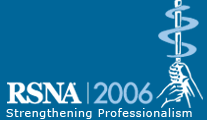
Abstract Archives of the RSNA, 2006
SST06-09
Use of Advanced Visualization Tools in 64-slice CT Coronary Angiography and Impact on Diagnostic Accuracy: A Comparison to Quantitative Coronary Angiography
Scientific Papers
Presented on December 1, 2006
Presented as part of SST06: Cardiac (CT)
Christopher Herzog MD, Presenter: Nothing to Disclose
Peter Zwerner MD, Abstract Co-Author: Nothing to Disclose
Giancarlo Savino MD, Abstract Co-Author: Nothing to Disclose
Philip Costello MD, Abstract Co-Author: Speakers Bureau, General Electric Company
Speakers Bureau, Bracco Group
Thomas Josef Vogl MD, Abstract Co-Author: Nothing to Disclose
U. Joseph Schoepf MD, Abstract Co-Author: Research grant, Schering AG (Berlex Inc)
Research grant, Bracco Group
Research grant, General Electric Company
Research grant, Schering AG (MEDRAD, Inc)
Research grant, Siemens AG
Consultant, Schering AG (Berlex Inc)
Consultant, Bracco Group
Consultant, General Electric Company
Consultant, Siemens AG
Consultant, PAION AG
To investigate the impact of advanced image visualization tools on diagnostic accuracy in patients scheduled for 64-slice multi detector-row CT coronary angiography (64-MDCT).
36 patients with suspected coronary artery disease (CAD) underwent both 64-MDCT (Siemens) of the coronary arteries and invasive coronary angiography. Each data set was analyzed twice by two experienced observers and by using of standard 3D-reformation techniques (MIP, MPR) either with or without use of an advanced image visualization tool (AVT) (Circulation, Siemens). Finally the results of both methods were interpreted in combination. Image quality (1-5)and extent of coronary artery disease (0-100% stenosis) was assessed on a per-segment basis. CHI2-tests were used for statistical analysis.
Globally, all CT coronary angiograms (36/36) were considered of diagnostic quality. Mean image quality was rated good (4.1+0.3). 92.6% (500/540) of all segments were assessable without and 90.7% (490/540) with use of AVT respectively. Correlation coefficients for detection and grading of stenoses was r=0.41 without use of AVT, r=0.16 with use of AVT and r=0.64 for the combination of both (p50%) was identified with 41.46% (17/41) sensitivity and 90.98% (454/499) specificity without use of AVT, with 73.17% (30/41) sensitivity and 69.34% (346/499) specificity ( 65.09% , 73.36% ) with use of AVT and with 80.49% (33/41) sensitivity and 96.19% (480/499) specificity ( 94.12% , 97.69% )when using AVT after previous visual assessment. The combination of both led to significant (p<0.05) better results than any of the methods alone.
In MDCT coronary imaging AVT are not suited as a single method for the detection and grading of coronary artery stenosis. However, if applied after previous visual inspection, they help quantifying the effective degree of stenosis and thus increasing diagnostic accuracy.
In MDCT cardiac imaging use of advanced image visualization tools is only beneficial if applied after previous visual inspection of the coronary arteries.
Herzog, C,
Zwerner, P,
Savino, G,
Costello, P,
Vogl, T,
Schoepf, U,
Use of Advanced Visualization Tools in 64-slice CT Coronary Angiography and Impact on Diagnostic Accuracy: A Comparison to Quantitative Coronary Angiography. Radiological Society of North America 2006 Scientific Assembly and Annual Meeting, November 26 - December 1, 2006 ,Chicago IL.
http://archive.rsna.org/2006/4441822.html

